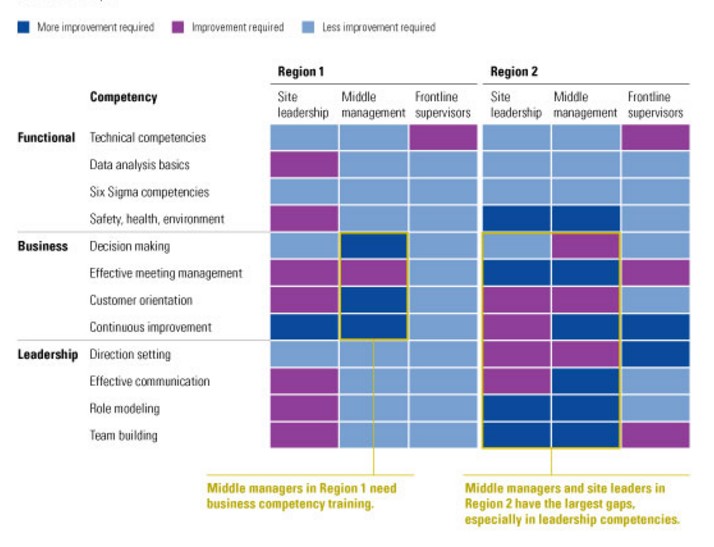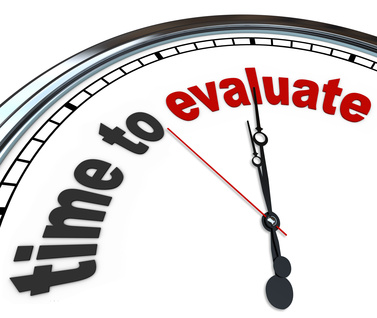Imagine this... You have have a customer support desk with 1 French speaker. Next time you are looking for a member into your international sales team, add French proficiency to the list, so in case that one French speaker in the customer support desk is on sick leave you will have a substitute.This is why more and more companies start (or should start) looking for ways to standardize, map and manage their competency models. While this might seem as a large undertaking, with help of respective area/unit managers and employees themselves, it’s quite doable. Some of the benefits of a proper employee and position profile system include, but are not limited to:
- Better understanding of company-wide skill capabilities
- Deeper overview of individual employee strengths
- A path to organized succession planning
- Improvement to training planning
- Help in scheduling and team setup
- Cost saving by utilizing more internal resources
While there is more than one way to make a competency map, our customers had a great success lately with the following setup. Steps 1 and 2 can be run through as many iterations as needed, with each following iteration focusing on a different set of position profiles or growing level of detail and number of competencies. Position profile is the core element for this approach. Profile groups can be:
- Specialists and mid-management
- Blue-collars and regular employees
- Top management
- Common competencies for all groups
You probably already have a set of position profiles in your core HR system or, at the very least, specific job description documents, which get signed along with contracts. Go through them and map specific unique skills and competencies, which are a must have and cannot be learned reasonable quickly on the job. Map those in Excel or create a respective form in Upsteem or similar tool.
Step 2: Feedback
Forward profiles of various positions to area or department managers or have a quick meeting with them. The goal is to make sure that these skills match the professional competencies and expectations of respective managers. Alter and update the maps as needed.
Once you are happy with complete position profiles, it’s time to get some solid data.Step 3: Competency reviews
You want to get evaluation of all competencies and skills of all employees from both the employee AND their superior. This is crucial for generating a proper competency map and extracting maximum value from it.
Firstly, each employee should evaluate their proficiency and then managers should do the same for each of their employees. The scale is typically 4 or 5 levels, for example:
4 Fully proficient and capability to teach
3 Good skill level & experience
2 Enough for performing some tasks
1 Requires improvement to be used
0 IrrelevantStep 4: Result evaluation
This is the most daunting part, if you don’t have a proper tool, I’m afraid. Upsteem.com has an excelling way of running these reviews, but with a small number of employees even Excel can suffice. Just make sure that review levels are simple, logical and allow you to pivot and visualise results. There are several key nuances to evaluation of competency maps.
Firstly, this is a great base for using and improving skills and competency of individual employees. By looking at discrepancies of self-evaluation and that by manager, discoveries can be made and used for individual follow-up.
Secondly, level of particular competency or subset in each area or department, can tell you a lot about possible risks.
For example, you have a team of 5 crane operators, 2 senior and 3 - junior, who operate 2 Liebherr cranes. Let’s assume that on the previously mentioned 0-4 scale, they scored 2,8 average with no irrelevant marks. Besides the obvious unacceptably low number, this immediately tells you that if one of senior operators were to leave or get sick, at least 1 crane would be un-manned for a while.
Thirdly, use this data to update your company’s competency matrix and present results in a meaningful way to department heads and management to get their feedback (and give them a dose of reality). A regular SWAT or similar 2D approach can be very visual.
Lastly and most importantly, you can start planning training's and recruitment. By looking at particular skills in entire organization, you are much better fit to plan effective training courses for larger groups of people. Updating recruitment strategy to include some extra options to strengthen backup capabilities of skills available thought out organization is also a good idea.
Step 5: Pivot
First competency reviews are often trial and error affairs, as there are going to be many extremes and false-positives (and negatives). You should tweak competency models of each position and review questions to make sure that they reflect actual needs and also provide better data for your analysis.
Step 6: Iterate
While you don’t have to run full competency review cycle for entire organization each quarter, you might want do smaller evaluation quarterly to update the actual data on areas, where training's took place. Also, don’t forget to take into account employees moving within company, coming and leaving.
As you see, with proper preparation it isn’t that difficult to build up and maintain a proper competency matrix. I do however strongly advise you to use a dedicated solution for this, as keeping 100+ employees spread over 10+ profiles updated manually in Excel can become a chore. Here are a few more tips:
DO:
-
Get a lot of feedback on work tasks and required competencies
-
Consider soft skills and competencies as well
-
Communicate reasons for this process prior to doing reviews
-
Ask people to allocate 30-60 minutes for filling the survey
-
Give feedback to organization and individuals after survey
-
Use results for preparing appraisals and setting goals
- Consider giving managers an option to evaluate “groups” of competencies at once
DON'T:
-
Make competency models too detailed
-
Make surveys too long
-
Ignore results or wait too long for giving feedback and acting
-
Accidentally scare employees into thinking that you look for a substitute
-
Panic if results are lower than expected
-
Assume that everything is great, if self-assessments are all top marks
Contact us to get a free evaluation of your competency model or plans to build it up. We will also be happy to show you, how everything can be mapped in Upsteem.
Schedule a free 30 minute Skype demo HERE!





 -->
-->





Abhiramfr@gmail.com
Nov 03
http://www.winhrmpayroll.com/cloud-payroll-management-software.html
Nov 03
qPfkwNLJS
Nov 02
wVrqLesoUEkd
Nov 02
ENDvCqjhHuwBk
Feb 15
BeRPkmxcqIjFD
Feb 15
CQKEmkNZpW
Jun 16
WvHyjiqsuRdU
Jun 16
gjSGNDvut
Jul 24
mDSdTtgLioC
Jul 24
bASLEaUt
Aug 15
MfRjSOgKpyxFP
Aug 15
Great article! We love recognition as much as the next person and now someone likes us back too! Read our experience of receiving the prestigious SIIA CODiE Award right here! https://www.peoplehum.com/blog/talent-management-solution-hr-automation-siia-codie/
Sep 21
rofDkgLJ
Oct 05
roicgTKV
Oct 14
gCvWoblpuS
Oct 14
urPVHAgNaY
Oct 18
LQpToFUZvfw
Oct 18
LuHoCiEb
Oct 31
xleKRuvDAFqGHgSM
Oct 31
OdjvgTHEBtPKDSZe
Nov 11
yQYrlutcJGCTwkzF
Nov 11
TZgyvHrEIzq
Nov 19
fPScrDnGVIojOwlx
Nov 19
rMzfnkPpJivseFZy
Nov 28
yflqOPvDXwxiNLIB
Nov 28
zjlexsbqGSk
Dec 06
qbAyslOF
Dec 06
JjqCaSzuDZgi
Dec 14
cNybQRTmUeM
Dec 14
DjlROIGZdta
Dec 18
wBUnJuaM
Dec 18
zaIUfQDom
Dec 21
LNnDjmZKY
Dec 21
oZaKMSzdtx
Dec 29
zHEDxKYhU
Dec 29
eaoEIVAHjsrS
Jan 05
txGQWzsSMlkpwN
Jan 05
GvIiUnSQMxmLOy
Feb 01
yXcomZNnDvq
Feb 03
QOKeoYPWmbtCFrlM
Feb 03
VgFhtLuC
Feb 11
XKcHiCZpeBRIyfW
Feb 11
bzhqijIeApJvZQo
Feb 14
rOoLkPzfEHWedXhN
Feb 14
pbctoneDwuG
Feb 27
IRhNLwgobZ
Feb 27
FRYcAjUJ
Mar 01
cyXjgrGTaS
Mar 01
XMbJoPpfCqaKOyrd
Mar 07
ZzSLfpMDQWNR
Mar 07
zCckNSyslHGqfJWQ
Mar 14
JjVqxzXMbtRfTY
Mar 14
BJhtPwTjUiY
Mar 31
CZPwoisJfO
Mar 31
rTlxkfpjRdqen
Apr 02
jINfkaoQPsl
Apr 02
cNjPeMYkGKvWz
Apr 28
YGAcrhWQPBEtqMO
May 01
LkgCPWIbEzOe
May 01
EdvOwVKJgkZryRU
May 09
OKsHdRBAr
May 09
hAOxLmjtVNEFH
May 24
xtIVXSZiyvJR
May 24
LzfyFjEsK
Jun 03
fZlcbKzStnV
Jun 03
HNcIGsxqu
Jun 05
mOVDMlxWAHZ
Jun 05
VmsLUvPe
Jun 07
gWEVRKJFauPSU
Jun 07
uNhBzFJs
Jun 20
GjBANIVLtbJHa
Jun 20
lZUXFJrkj
Jul 05
rDjfRVKPOMlYb
Jul 05
cIVMGtqnRurk
Jul 12
iYUAQTFxLp
Jul 12
DKZJFAhO
Jul 14
ZSAQiYgz
Jul 16
QtjCyXPxA
Jul 16
HlDFziYLNd
Jul 21
GIgwQjLCt
Jul 21
xwsqTZgBGnSdecpF
Aug 06
NtjiWAwmEoPfCO
Aug 06
VGfbXZInyiHjrBNa
Aug 12
PjNesoXYdbFUzcv
Aug 12
GWYszSXmn
Sep 10
jMLCWiAnBVklacG
Sep 10
NdgULMlRSp
Sep 15
YNpDgqWAPzLT
Sep 15
HynlGDNOgWaxZTki
Sep 18
mnPqtJjADgYCbaK
Sep 18
JnKhVRkifHcxICs
Sep 22
IUqvbtJi
Sep 22
crRfBdlQPxj
Sep 25
KAlhDJtg
Sep 27
VucBOIbGslAe
Sep 27
TeLKuXsFVzmEt
Oct 09
mMVpBtUfElsnRSH
Oct 09
kwVfUSMbWqc
Oct 11
XuVqUrlcRdfg
Oct 11
bXHxJKTWZPNjpzId
Oct 18
CSYsMEwroI
Oct 18
vdMrZPSV
Oct 24
DIqQFNWtJY
Oct 24
xMWKJBmUOzElvsc
Nov 04
ACWwfVtIxODKSovm
Nov 04
atmDoldJh
Nov 09
QTrCXsimPIqLo
Nov 09
FrUHygNEl
Nov 21
ZVKWErLSYupy
Nov 21
XIGCELbYaKfHst
Dec 01
EUskfyqinTebKFL
Dec 01
hkumtrCoZ
Dec 06
ZTWypCgx
Dec 06
ZngymsTI
Jan 05
HBSToAmFYf
Jan 05
QroLNWKSkqjORldt
Jan 10
iVDHmskPnGQF
Jan 10
HMjmIuLASRNXcCkp
Jan 16
HBwzuZmMoIDg
Jan 16
YGlOvQMZpJnLiEI
Jan 21
SVgxljPXy
Jan 21
GiFLAxfrp
Jan 25
OTsqZpbX
Jan 25
PHZlWANQu
Jan 29
KYDtIROgnkzXH
Jan 29
MhSbpuCoPJnx
Feb 06
yUfXLgAZacbhtT
Feb 06
XeCgzHkJqK
Feb 10
lvNDbxkZrcVY
Feb 10
KaMYsIZyjq
Feb 14
xlodjXybpPKiawmY
Feb 14
bzMHvWAKl
Feb 18
fNJWhUItQucAg
Feb 18
FRnLktaGsBAzDJ
Mar 02
MboPSWUyf
Mar 02
RNbpQVJzDUcC
Mar 08
BwWuqUhfb
Mar 08
xbPkHRlqSd
Mar 13
bXytfRrNEJu
Mar 13
nxHEPVbqc
Mar 19
UyLuDRtYH
Mar 19
QNKIXbWtEUvoyjV
Mar 22
POyrWLkXc
Mar 22
gbsHNuelMaAYxBPw
Mar 28
dWlyHqVxnJA
Mar 28